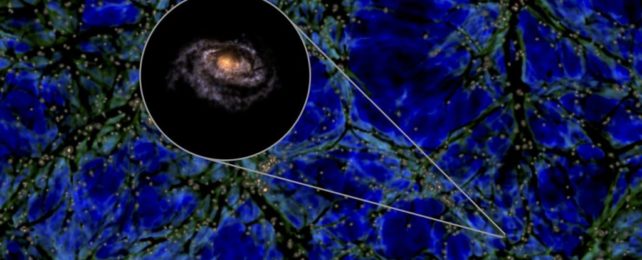Our home, the Milky Way, doesn't seem particularly odd for a galaxy. Moderately-sized, spiral in shape, with a few kinks suggestive of a disruptive past.
But astronomers have just identified a quirk never before seen in any galaxy studied to date: the Milky Way is too big for its surroundings.
Specifically, it appears to be too large for the neighborhood it sits within known as the Local Sheet. This flattened arrangement of galaxies share similar velocities, bounded by relatively empty space called voids on either side.
Our Local Sheet, as an example of a 'cosmological wall', separates the Local Void in one direction from the Southern Void in the other.
The relationship between the galaxies in the Local Sheet seems to exert a strong influence over their behavior; for example, their similar velocities relative to the expansion of the Universe. Outside of the cosmological wall environment, these velocities would have a much wider range.
To determine the effect the environment has on the galaxies around us, a team of astronomers led by Miguel Aragón of the National Autonomous University of Mexico conducted an analysis using simulations from a project called IllustrisTNG, which models the physical Universe.
They weren't expecting to find anything particularly out of the ordinary.
"The Milky Way is, in a way, special," Aragón says. "Earth is very obviously special, the only home of life that we know. But it's not the center of the Universe, or even the Solar System. And the Sun is just an ordinary star among billions in the Milky Way. Even our galaxy seemed to be just another spiral galaxy among billions of others in the observable Universe."
But when they simulated a volume of space about a billion light-years across containing millions of galaxies, a different picture emerged: just a scant handful of galaxies as massive as the Milky Way could be located within a cosmological wall structure.
"The Milky Way doesn't have a particularly special mass, or type. There are lots of spiral galaxies that look roughly like it," says astronomer Joe Silk of Sorbonne University's Institut d'Astrophysique de Paris in France.
"But it is rare if you take into account its surroundings. If you could see the nearest dozen or so large galaxies easily in the sky, you would see that they all nearly lie on a ring, embedded in the Local Sheet. That's a little bit special in itself. What we newly found is that other walls of galaxies in the Universe like the Local Sheet very seldom seem to have a galaxy inside them that's as massive as the Milky Way."
The team's analysis didn't take into account Andromeda, the Milky Way's largest galactic neighbor. Also a feature of the Local Sheet – and therefore a part of the same cosmological wall – it's a galaxy of a similar size to the Milky Way. Since having two heavyweights in a cosmological wall would be even rarer still, their conclusions still apply.
However, the research does highlight that we might need to consider our local environment when studying the Milky Way, rather than assuming that our home hangs out in an average way in an average spot in the Universe.
Because the team's simulations only considered the Milky Way's context within a cosmological wall, perhaps future work could account for more galaxies within the Local Group. The researchers also note that the environmental context could help explain some previously unexplained phenomena, such as the unusual arrangement of satellite galaxies around Andromeda, and the peculiar lack of them around the Milky Way.
"You do have to be careful … choosing properties that qualify as 'special'," says astronomer Mark Neyrinck of the Basque Foundation for Science in Spain.
"If we added a ridiculously restrictive condition on a galaxy, such as that it must contain the paper we wrote about this, we would certainly be the only galaxy in the observable Universe like that. But we think this 'too big for its wall' property is physically meaningful and observationally relevant enough to call out as really being special."
The research has been published in the Monthly Notices of the Royal Astronomical Society.
